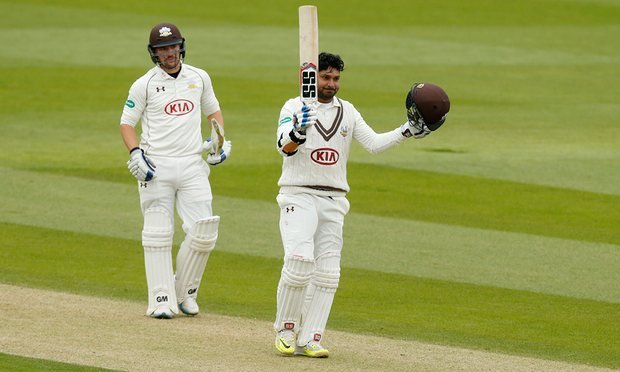Spectators, hardy people all given the knifing northerly wind, were still trickling through the Hobbs Gate when Craig Overton gained an lbw decision against Arun Harinath and Kumar Sangakkara came to the wicket. Did they know, one wonders, that it was this very date in 1905 that Jack Hobbs – 23 years old and destined to become known as The Master, the most prolific scorer of centuries the game has seen – made his first-class debut at The Oval, for Surrey against the Gentlemen of England, and marked it by scoring 18 and 88?
Now, 111 years on, another batting master produced a display of such skill and aesthetic quality that other batsmen, good players in the modern mode such as Rory Burns (80) and Jason Roy (85) were made to look journeymen by comparison.
Sangakkara made 171 exquisite runs before, intent perhaps on trying to reach with a fusillade of shots the fifth county double century of this as yet infant season, he larruped the pace of Tim Groenewald through a distracting cloud of fluttering pigeons to Overton at deep extra cover and marched briskly from the arena.
The Somerset players were quick to shake him warmly by the hand as he made his way back to the dressing room (the only warm thing about the day) but they would have done so as much out of relief at his parting as admiration for his masterclass: well played but enough really is enough.
This was an innings characterised by full-blooded clinical strokeplay, though not so much murder by bludgeon for the bowlers as death by a thousand cuts. He was calculating while his innings was gaining its sea legs, forcing off the back foot as the bowlers, wary of pitching up too far on a fine batting surface, held their lengths back a fraction too far (no player of his generation picks up the length quicker than Sangakkara) and legside strokes clipped as precisely as a colonel’s moustache. Some stroke the ball, others brutalise it: Sangakkara simply lacerates it, a combination of strength of sinew, timing and whipcord wrists. When he drove through extra cover to bring him many of his 24 boundaries, he did so while virtually down on one knee, the precision of his placement rendering redundant even those fielders scouting the outer perimeters of the widest ground in the land playing almost to its maximum.
There were sixes too, four of them in an innings of all but four hours and scored at a shade over a run a ball. One of them, off the left-arm spin of Roelof van der Merwe, clobbered vigorously from down the track and over long-on, took him from 99 to 105, his century coming from only 94 balls. At one stage, after what must have been a hearty lunch, he took a particular shine to Overton’s bustling pace, belting him ruthlessly from front foot and back, so that the bowler was forced to resort to bouncers simply to keep things in check.
It was Sangakkara’s stand with Burns that set up what, by the close, was already a formidable Surrey total of 394 for five. The partnership of 187, ended when Burns, beaten perhaps by Van der Merwe’s flight and checking a drive, was caught and bowled, was one of contrasts. Burns crouches low, backside jutting, in the manner of Eoin Morgan a couple of years ago. It looks manufactured, slightly awkward, with, as Morgan found, a headbobbing threat. His partner was upright, balanced and alert, an economy of effort making batting look simple. They say that Hobbs was the same.
– Guardian News









![TV-Poster-All-Exhibition-Sri-Lanka-in-Focus-USA-2025[1]](https://www.srilankafoundation.org/wp-content/uploads/2025/04/TV-Poster-All-Exhibition-Sri-Lanka-in-Focus-USA-20251-450x450.jpg)












